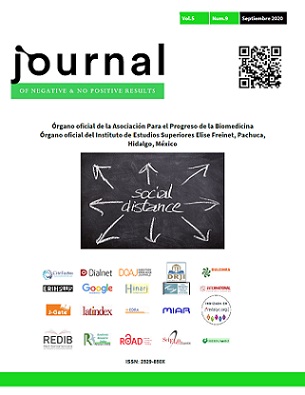Biopreparations for the control of strawberry leaf diseases, Pamplona, Colombia, even a partial solution
DOI:
https://doi.org/10.19230/jonnpr.3419Keywords:
Fragaria × ananassa, biopreparations, alternative controlAbstract
Objetive. The work aimed to determine the efficacy of six local biopreparations for the control of leaf diseases of strawberry cultivation.
Materials and Methods. An experiment was conducted at the Camacho farm in the municipality of Pamplona Norte de Santander, Colombia. A randomized block design was used with nine treatments, six local biopreparations, three controls (one sanitized, one unsanitary and one chemical).
Results. The most important foliar diseases of the strawberry were Ramularia tulasnei, Colletotrichum sp., Botrytis cinerea and Xanthomonas fragariae. The biopreparations Rhizosphere Broth and Efficient Microorganisms (ME) are superior to the chemical treatment with mancozeb for the spot by Ramularia. The bio-products Rhizphere Broth and ME showed similar results that the chemical control against Botrytis rot, Xanthomonas spot, and anthracnose on leaves, flowers and fruits, but the incidence levels of this disease were between 46 and 55% in flowers and between 56 and 63% in fruits.
Conclusions. The biopreparations Rhizphere Broth and ME were superior to the chemical treatment with Dithane to maintain the spot by Ramularia at acceptable levels of severity, as well as the bacterial spot and Botrytis rot, and although they were similar to the chemical control against anthracnose in leaves, flowers and fruits, however, the levels of incidence anthracnose in flowers and fruits are not desired, threatening the profitability of the farmer.
Downloads
References
FAO. 2002. La agricultura mundial 2015-20130. 2002. http://www.fao.org/3/ay3557s.pdf
Ortiz R, Villadiego J, Cardona, C. Valoración de los impactos ambientales totales generados por el uso de plaguicidas en actividades ganaderas en el municipio de pamplona-norte de Santander-Colombia. Revista de Didáctica Ambiental. 2011 Dic;7(10):62-80.
Serret M, Espinosa D, Gómez O, Delgadillo J. (2016). Tolerancia de plantas de fresa (Fragaria´ananassa Duch.) premicorrizadas con Rhizophagus intraradices e inoculadas con PGPR’s a Phytophthora capsici. Agrociencia, 2016;50:1107-1121. 2016
Escobar R. Las prácticas agrícolas y su incidencia en la calidad y productividad de fresas (Fragaria vesca) variedad Albión, Ecuador III Congreso Científico Internacional UNIANDES. 2015 2p. Disponible en https://www.uniandes.edu.ec/web/wpcontent/uploads/2016/04/Las-pr%C3%A1cticas-agr%C3%ADcolas-y-su- incidencia-enla-calidad-y-productividad-de-fresas-Fragaria-vesca-variedad-Albi%C3%B3n.pdf.
Bolda M, Koike ST. Mildiu polvoroso en la fresa, Guía de Producción por Mark Bolda & Steven T. Koike, México, California Strawberry Commission, 2015. Disponible en https://www.calstrawberry.com/Portals/2/Reports/Research%20Reports/Production%20Guidelines/Spanish/Mil diu%20polvoroso%20en%20la%20fresa%20-%202015.pdf?ver=2018-01-12-075448-283.
Universidad de California. Guía para el manejo de las plagas: Fresas. 2005. 70p. Disponible en http://www.oregonstrawberries.org/fmr/fact_sheets/Guia__Fresas_Espanol.pdf
FAO. Xanthomonas fragariae, Organización de las Naciones Unidas para la Alimentación y la Agricultura. 2016. 14p. Disponible en https://www.ippc.int/static/media/files/publication/es/2017/02/DP_14_2016_Es_2017-01- 23.pdf
BID, B. Manual Práctico de uso de ME. Convenio fondo especial de Japón. Uruguay. 2009. Disponible en https://www.emuruguay.org/images/Manual_Practico_Uso_EM_OISCA_BID.pdf
Castro L, Murillo M, Uribe L, Mata R. Inoculacion al suelo con pseudomonas fluorecens, Azospirillum Oryzae, Bacillus subtilis y Microorganismos de Montaña (MM) y su efecto sobre un sistema de rotación soya-tomate bajo condiciones de invernadero. Agronomia costarriense. 2015; 39(3):21-36.
Campbell, C.L. y Madden, L.V. (1990). Introduction to Plant Disease Epidemiology. Wiley, New York, USA. 1990.
Castellanos L, Céspedes NE, Sequeda A, Jaime JE, Niño LJ. Caracterización Microbiológica de seis Biopreparados Artesanales. Revista Científica. 2018;6(3):57-65.
Lara C, Esquivel L, Negrete J. Bacterias nativas solubilizadoras de fosfatos para incrementar los cultivos en el departamento de Córdoba-Colombia. Biotecnología en el sector agropecuario y agroindustrial. 2011;9(2):114- 120.
Coutinho FM. Programa de extensão “Divulgação das Plantas Medicinais, da Homeopatia e da Produção de Alimentos Orgânicos”. Cuaderno los Microrganismos Eficientes (EM). Instruções práticas sobre uso Ecológico e social do EM. Viçosa: Universida de Federal de Viçosa. 2011.
Tokata, RK, Strap J.L, Jung, C.M, Crawford, D.L., Salove, M.H., Deobald, L., Bailey, J., Morra, M.J. (2002) Novel plant–microbe rhizosphere interaction involving Streptomyces iydicus WYEC108 and the pea plant (Pisum sativum). Applied and Environmental Microbiology 68:
Arasu MV, Esmail GA, Al-Dhabi NA, Ponmurugan K. Managing Pests and Diseases of Grain Legumes with Secondary Metabolites from Actinomycetes. In: Subramaniam G., Arumugam S., Rajendran V. (eds) Plant Growth Promoting Actinobacteria. Singapore: Springer. 2016.
Quezada AP. (2011). Evaluación del comportamiento de fungicidas microbiológicos en la prevención de Botrytis en el cultivo de fresa (Fragaria vesca). Tesis en opción al grado de Master en gestión de la producción de flores y frutas andinas para exportación. Universidad Técnica de Ambato. Ecuador. 2011. Disponible en http://repositorio.uta.edu.ec/jspui/bitstream/123456789/1680/1/tesis-0006%20Gesti%c3%b3n%20de%20la%20prod.%20de%20flores%20y%20Frut.....pdf
Merchán JB, Ferrucho RL, Álvarez JG. Efecto de dos cepas de Trichoderma en el control de Botrytis cinerea y la calidad del fruto en fresa (Fragaria sp.) Revista Colombiana de Ciencias Hortícolas.2014;8(1):44-56.
Niño EC, Guerrero O. (2011) Efecto de Trichoderma lignorum y Sacharomyces cerevisiae en el control del hongo Botrytis cinerea causante del moho gris de la fresa y su rendimiento,en el municipio de Subachoque Cundinamarca. Inventum. 2011;11:1-20.
Published
Issue
Section
License
All accepted originals remain the property of JONNPR. In the event of publication, the authors exclusively transfer their rights of reproduction, distribution, translation and public communication (by any sound, audiovisual or electronic medium or format) of their work. To do so, the authors shall sign a letter transferring these rights when sending the paper via the online manuscript management system.
The articles published in the journal are freely used under the terms of the Creative Commons BY NC SA license, therefore.
You are free to:
Share — copy and redistribute the material in any medium or format
Adapt — remix, transform, and build upon the material
The licensor cannot revoke these freedoms as long as you follow the license terms.
Under the following terms:
Attribution — You must give appropriate credit, provide a link to the license, and indicate if changes were made. You may do so in any reasonable manner, but not in any way that suggests the licensor endorses you or your use.
NonCommercial — You may not use the material for commercial purposes.
ShareAlike — If you remix, transform, or build upon the material, you must distribute your contributions under the same license as the original.
No additional restrictions — You may not apply legal terms or technological measures that legally restrict others from doing anything the license permits.

This work is licensed under a Creative Commons Attribution-NonCommercial-ShareAlike 4.0 International License

























